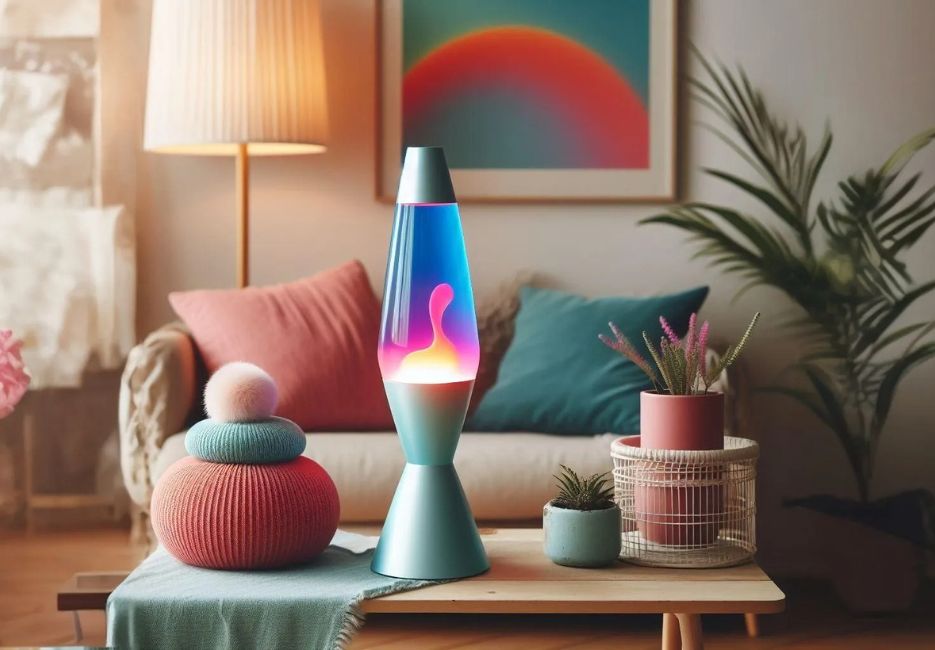Lava lamps are made of a combination of fascinating components that work together to create their mesmerizing display. The main components of a lava lamp include a glass container and a special liquid mixture. The glass container is typically designed in a tall cylinder or cone shape, with a base that houses the electrical components needed for the lamp to function.
The liquid mixture inside a lava lamp is a unique blend of two immiscible liquids: water and oil. The oil used is usually mineral oil, which has a higher density than water. This density contrast is essential for the formation of the lava lamp’s characteristic lava-like blobs. To enhance the visual appeal of the lava lamp, the oil is mixed with various additives such as wax or colored dyes. These additives form globules that rise and fall within the lamp, creating the mesmerizing flow that lava lamps are known for.
By understanding the components that make up lava lamps, we can better appreciate the artistry and craftsmanship that goes into creating these iconic pieces of decor.
The History of Lava Lamps
Lava lamps were invented by Edward Craven Walker, a British accountant and entrepreneur, in the 1960s. Walker was inspired by an unusual liquid-filled egg timer he saw in a pub, which had a mesmerizing floating effect. He spent years experimenting with different combinations of liquids and additives to create the perfect lava lamp.
The lava lamp became a popular symbol of the counterculture movement of the 1960s and 1970s, representing peace, love, and psychedelic aesthetics. It was often used as a decorative item in homes, music venues, and other spaces associated with the hippie culture.
Today, lava lamps are still beloved for their retro charm and unique visual appeal.
The Components of Lava Lamps
Lava lamps consist of two main components: a glass container and a special liquid mixture. The glass container is typically shaped like a tall cylinder or a cone, with a base that holds the electrical components.
The liquid mixture inside a lava lamp is composed of two immiscible liquids: water and oil. The oil used is usually mineral oil, which has a higher density than water. This density difference is crucial for creating the lava lamp’s signature lava-like blobs.
To achieve the mesmerizing lava effect, the oil is mixed with various additives such as wax or colored dyes. The wax or dye forms globules that rise and fall within the lamp when heated, creating the illusion of lava flowing.
How Lava Lamps Work
Lava lamps work based on the principle of heat convection. When the lamp is turned on, the heat from the bulb at the base of the lamp warms up the liquid mixture. The heat causes the wax or dye globules to expand and become less dense, making them rise to the top of the lamp.
As the globules reach the top, they cool down and become denser again, causing them to sink back down. This continuous cycle of rising and falling creates the mesmerizing lava lamp effect.
The heat from the bulb is controlled by a thermostat, which ensures that the temperature remains within the optimal range for the globules to flow smoothly.
Popular Variations of Lava Lamps
Over the years, lava lamps have evolved to offer a wide range of variations to suit different tastes and preferences. Some popular variations include:
- Lava lamps with glitter: These lamps feature glitter suspended in the liquid mixture, adding an extra sparkle to the lava effect.
- Lava lamps with metallic or patterned bases: These lamps come with bases made of metallic materials or adorned with unique patterns, adding a touch of style to the overall design.
- Lava lamps with color-changing bulbs: These lamps have bulbs that can change colors, creating a dynamic and visually stunning display.
- Giant lava lamps: These lamps are much larger in size compared to traditional lava lamps, making them a striking centerpiece in any room.
With these variations, lava lamp has become not only a source of ambient lighting but also a statement piece of decor.
Tips for Taking Care of Your Lava Lamp
To ensure the longevity and optimal performance of your lava lamp, here are some tips for taking care of it:
- Place the lava lamp on a stable surface away from direct sunlight and heat sources. Direct exposure to heat can cause the wax or dye to become too fluid or discolored.
- Avoid shaking or moving the lava lamp while it is in operation. This can disrupt the flow of the globules and affect the overall performance.
- Clean the glass container regularly with a soft cloth to remove any dust or fingerprints. This will help maintain the clarity of the glass and enhance the visual appeal of the lava lamp.
- If the lava lamp is not in use for an extended period, it is recommended to turn it off and allow it to cool completely before storing it.
By following these tips, you can enjoy the mesmerizing display of your lava lamp for years to come.

Ophelia Scott is a Lighting Specialist at Lamp Insider, with a rich background at Philips, where she honed her skills in crafting beautiful and functional lighting designs. She resides in Colorado and holds a degree from the University of Colorado Boulder.
